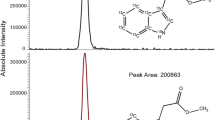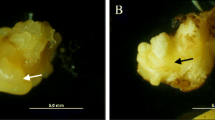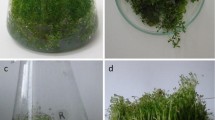Abstract
The uptake and metabolism of indole-3-acetic acid (IAA) and indole-3-butyric acid (IBA) were studied in suspension cell cultures of Petunia hybrida. The initial uptake of 3H-IBA was much higher than that of 3H-IAA, and after 10 min of incubation with labeled IBA and IAA, 4.6 pM vs 0.35 (39% vs 12% of total applied radioactivity) respectively, were found in the cell extracts. The uptake of IBA reached a plateau of 6.0 pM (62%) after 2 h while that of IAA increased continuously up to 1.5 pM (46%) after 24 h. Following the addition of 40 µM of unlabeled auxin more IBA was taken in initially than IAA (39% vs 12%), but the level almost equalized after 24 h of incubation when IBA uptake reached 890 nM (55%) and IAA 840 nM (46%).
IBA was metabolized very rapidly by Petunia cell suspension to new compounds. HPLC of the cell extracts demonstrated a new metabolite after only 2 min of incubation, and after 30 min 60% of the radioactivity was in the new metabolite vs 10% in the IBA. The new compound was resolved by autofluorography to two metabolites but after 24 h only one metabolite was present. The IBA metabolites were identified tentatively as IBA aspartic acid (IBAasp) and IBA glucose (IBAglu). In the medium IBA disappeared at a fast rate and after 24h most of the radioactivity was present in the new metabolite, probably IBAasp. IAA was also converted rapidly to two new metabolites and both were still present after 24 h. No attempt was made to identify the metabolites of IAA. IAA metabolism proceeded at a slower rate, and autofluorography showed that while free IBA disappeared after 0.5 h, free IAA was still present after 1 h of incubation. We postulate that Petunia cells conjugate IBA rapidly to IBAglu which in turn is converted to form IBAasp which probably acts as a ‘slow release’ hormone. Only intact cells were able to metabolize IBA and the reaction was affected by low temperature and anaerobic conditions. The fast rate of IBA uptake, the need for whole cells for the metabolism to proceed, and the fast change of IBA to a new metabolite in the medium, all suggest that both uptake and metabolism of IBA in Petunia cells occur on the cell surface.
Similar content being viewed by others
References
Aranda AM, Tabet G, Leguay J-J and Caboche MG (1984 Identification of NAA-L-aspartate as the major metabolite synthesized by tobacco mesophyll protoplasts incubated in the presence of the auxin analogue NAA. Phytochemistry 23:1221–1223
Bandurski RS and Schulze A (1977) Concentration of indole-3-acetic acid and its derivatives in plants. Plant Physiol 60: 211–213
Caboche M, Aranda G, Poll AM, Huet J-C and Leguay J-J (1984) Auxin conjugation by tobacco mesophyll protoplasts. Correlations between auxin cytotoxicity under low density growth conditions and induction of conjugation processes at high density. Plant Physiol 75: 54–59
Cohen JD and Bandurski RS (1982) Chemistry and physiology of the bound auxins. Annu Rev Plant Physiol 33: 403–430
Cholodny NG 1935. Über das Keimunghormon von Gramineen. Planta 23: 289–312
Ehmann A (1977) The Van-Urk-Salkowski reagent — a sensitive and specific chromogenic reagent for silica gel thin layer detection and identification of indole derivatives. J Chromatogr 132: 267–276
Epstein E, Cohen JD and Chen K-H (1989) Identification of indole-3-butyric acid as an endogenous constituent of maize kernels and leaves. Plant Growth Reg 8: 215–223
Epstein E and Sagee O (1992) Effect of ethylene treatment on transport and metabolism of indole-3-butyric acid in citrus leaf midribs. Plant Growth Reg (In press)
Feung CS, Hamilton RH and Mumma RO (1971) Metabolism of 2,4-dichlorophenoxy-acetic acid by soybean cotyledon callus tissue cultures. J Agric Food Chem 19: 45–459
Libbert E, Wichner S, Durest E, Kaiser W, Kunert R, Manicki A, Manteuffel R, Riecke E and Schroder R (1968) Auxin content and auxin synthesis in sterile and non-sterile plants, with regards to epiphytic bacteria. In: F Wightman and Sutterfield G (eds) Biochem and Physiol of Plant Growth Substances, pp. 213–230
Michalczuk L and Bandurski RS (1982) Enzymatic synthesis of indol-3-yl-acetyl-1-O-β-D-glucose and indol-3-ylacetyl-myo-inositol. Biochem J 207: 273–291
Murashige T and Skoog F (1962) A revised method for rapid growth and bioassays with tobacco tissue cultures. Physiol Plant 15: 473–497
Scharf P and Günther G (1986) Formation and metabolism of IAA conjugates in Beta vulgaris and Chenopodium album. In: K Schreiber, Schotte HR and Sembdner G (eds) Proc. Int. Symp. Conjugated Plant Hormones, pp. 47–53
Scheel D and Sandermann H Jr (1981) Metabolism of 2,4-dichlorophenoxy-acetic acid in cell suspension cultures of soybean (Glycine max. L.) and wheat (Triticum aestivum L.). Planta 152: 248–252
Shea EM, Skaria A and Carpita NC (1988) Growth of carrot cell suspension cultures in medium containing amino acid conjugates of indoleacetic acid. J Plant Physiol 132: 298–302
Schneider EA, Kazakoff CW and Wightman F (1985) Gas chromatography-mass spectrometry evidence for several endogenous auxins in pea seedling organs. Planta 165: 232–241
Südi J (1966) Increases in the capacity of pea tissue to form acyl-aspartic acids specifically induced by auxins. New Phytol 65: 9–21
Venis MA (1972) Auxin-induced conjugation systems in peas. Plant Physiol 49: 24–27
Zenk MH (1964) Isolation, biosynthesis and function of indoleacetic acid conjugates. In: JP Nitch (ed) Régulateurs Naturels de la Croissance Végetale 5 th Int. Conf. Plant Growth Subst. pp. 241–249. Centre Nat. Recherches Sci. Paris
Author information
Authors and Affiliations
Rights and permissions
About this article
Cite this article
Epstein, E., Sagee, O. & Zelcer, A. Uptake and metabolism of indole-3-butyric acid and indole-3-acetic acid by Petunia cell suspension culture. Plant Growth Regul 13, 31–40 (1993). https://doi.org/10.1007/BF00207589
Received:
Accepted:
Issue Date:
DOI: https://doi.org/10.1007/BF00207589




